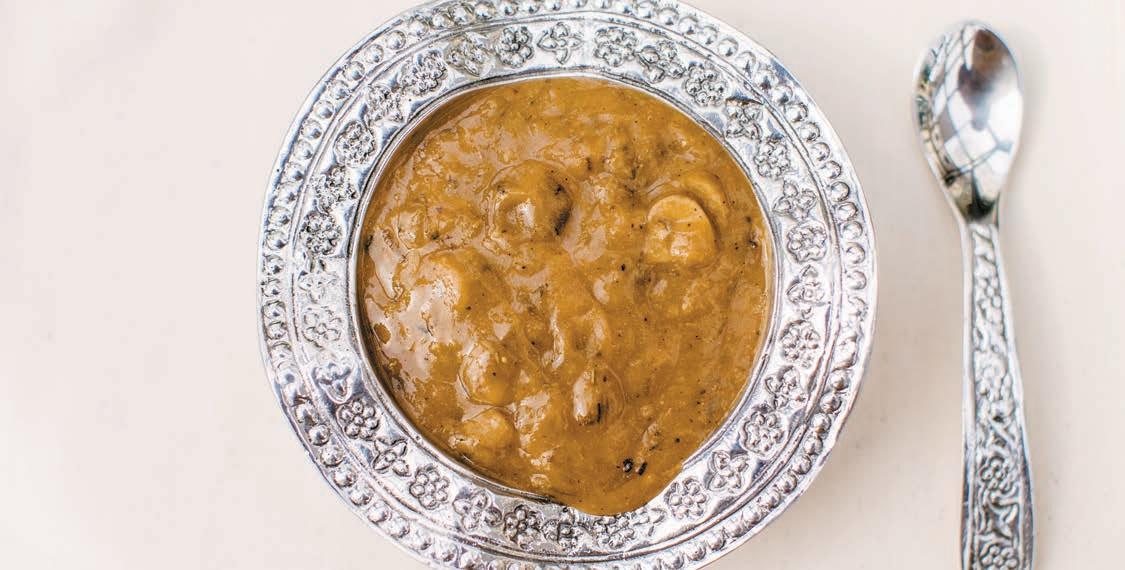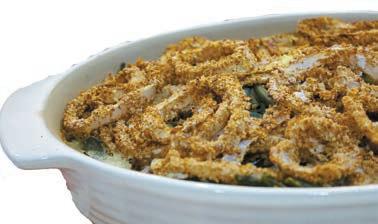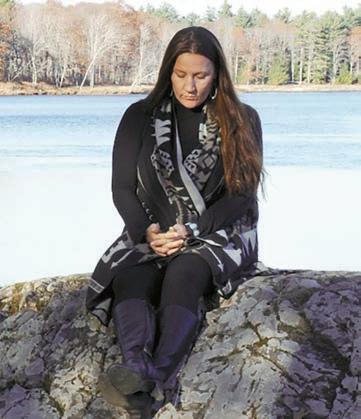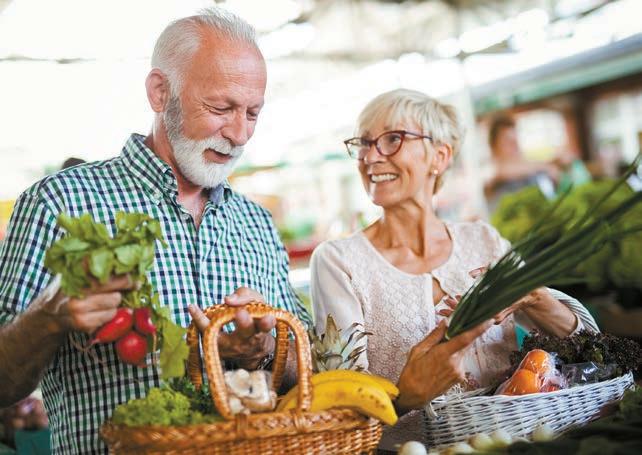
14 minute read
MINDFUL PARENTING
Mindful Parenting The Conscious Path to Raising a Child
dglimages/AdobeStock.com
Advertisement
by Ronica O’Hara
Lo Bannerman, a Tucson nutritionist, was making homemade cookies with her toddler. “Or rather, making a mess while stirring cookies,” she recalls. “Something in me snapped. I wanted to take control, kick her out of the kitchen and do everything the ‘right’ way.”
As Bannerman took a deep breath, a memory arose. “As a child, I was only allowed to count scoops of flour or teaspoons of vanilla. I was never allowed to fully, actively participate in the kitchen. Everything had to be perfect, and I was not ‘good enough’ to make it so. I felt this in my core. Was I passing this on to my daughter?” Bannerman recalls that, after taking a moment to reset, she and her daughter “happily made a mess, a memory and a foundation for a brighter future together.”
Bannerman, who blogs at NourishingFamilies.org, was practicing an increasingly popular approach in raising children known as either conscious, mindful, soulful, awake or peaceful parenting. Instead of focusing on shaping a child’s behavior through rules and discipline, which can bring up contentious issues of fear, ego and control, the focus is on connecting deeply with a child through love, authenticity and acceptance of the child’s innate nature.
“It’s crucial we realize that we aren’t raising a ‘mini-me’, but a spirit, throbbing with its own signature,” says psychologist Shefali Tsabary, Ph.D., author of The Conscious Parent: Transforming Ourselves, Empowering Our Children. “Children aren’t ours to possess or own in any way. When we know this in the depths of our soul, we tailor their raising to their needs rather than molding them to fit our needs.”
The transformation starts with—and hinges upon—parents understanding themselves deeply and realizing how their upbringing shapes their parenting actions. It’s not always easy, especially during housebound pandemic months. “Our children have the capacity to trigger us more than anyone else. So, when they exhibit childish behavior—which is, of course, part of their job description—it’s often hard for parents to stay calm,” says Laura Markham, Ph.D., a Brooklyn clinical psychologist and author of Peaceful Parent, Happy Kids.
“We see our child’s behavior (He hit her again!), and we draw a conclusion (He’s going to be a psychopath!) which triggers other conclusions (I’ve failed as a mother!). This cascade of thoughts creates a runaway train of emotions—in this case, fear, dismay, guilt. We can’t bear those feelings. The best defense is a good offense, so we lash out at our child in anger. The whole process takes all of two seconds, and later we wonder why we overreacted.”
The answer often lies in our past, Markham says. “Any issue that makes you feel like lashing out has roots in your own early years. We know this because we lose our ability to think clearly at those moments, and we start acting like children ourselves, throwing our own tantrums.”
The more deeply we know ourselves— whether through therapy, reading, journaling, meditation, mindfulness practices or simply facing head-on the hard knocks of life—the more open we are to forging a deep relationship with our children and the easier it is to calm ourselves in the moment of a trigger, psychologists say.
Correcting a child becomes then a matter of being a guide or coach, rather than a law enforcer. “Disciplining from a place of presence or awakened consciousness means having the willingness to pause, reflect, course-correct as needed in the moment, apologize, take ownership, ask for help and to drop history and reset as needed,” says Renée Peterson Trudeau, the Brevard, North Carolina, author of Nurturing the Soul of Your Family and The Mother’s Guide to Self-Renewal. “Most of all, practice self-compassion. You will make mistakes. Forgive yourself and move on; this is beautiful modeling for your kids.”
Jessica Speer, a family-book author in Steamboat Springs, Colorado, lives that process. Raised in a home “where anger wasn’t managed well,” she had no tools to draw on when she got triggered by her toddler’s tantrums. It was, she says, “a wake-up call that I needed help.” Diving deeply into books, mindfulness and meditation helped her to understand herself better. “Fast forward 10 years, and I still meditate regularly,” she says. “Now, when my daughter experiences big emotions, I try to ground myself so I can be there by her side. This has been so healing for both of us.”
Ronica O'Hara is a Denver-based health writer. Connect at OHaraRonica@gmail.com.
Marie Ruxton • LMT, CN •
Chronic Pain & Movement Therapy Myofascial Release Therapy Mind-Body Makeovers Therapeutic Massage
PA #MSG002015 NJ #18KT00415900
628 Chestnut St • Emmaus • 610.965.2500 www.marieruxton.massagetherapy.com Advertorial
With so many companies selling essential oils, are you confused???? How to Choose Essential Oils
“We take the stewardship of our planet seriously. Our State of the Art production process brings you the purest (essential) oils on Earth. We call it Seed To Seal®. It’s not a slogan — it’s our Calling.”
(By the Founder of YOUNG LIVING™ ESSENTIAL OILS)

YOUNG LIVING ESSENTIAL OILS — established over 20 years ago—laid the foundation for the company’s total commitment to using the purist seed, sustainable cultivation, optimum distillation, extensive testing of each batch of oils, and quality control inspection of each bottle to assure the purest, most potent essential oils available in the world. (SeedToSeal.com) Today, YOUNG LIVING’S Vision has grown into a world wide, essentialoil trend, and the trend is fueled by the consumer’s strong desire to bypass toxin-laden, synthetic scents used in many products. Unfortunately, as with any trend, many competitive companies have been spawned that attempt to convince the consumer that their products are “pure essential oils” too, but instead may utilize synthetic oil imitations, or oils made from genetically modified seeds, or oils diluted with carrier oils, or oils distilled from plants grown with pesticides and/or herbicides—all of which distorts, weakens and chemically changes the innate power of essential oils.
YOUNG LIVING ESSENTIAL OILS set the standard for authenticity 20 years ago, and that same high standard is still our “Calling” today — via our strict, Seed To Seal requirements used on all our company-owned farms and distilleries (in Utah; Idaho; France; Ecuador; British Columbia; Croatia; Israel, Taiwan) as well as on our Certified Partner-farms around the world. YOUNG LIVING also Partners with local Frankincense Harvesters in Oman to obtain our exclusive Sacred Frankincense Resin (from centuries-old Frankincense trees).
If you value true authenticity, always choose YOUNG LIVING ESSENTIAL OILS Info at: myYL.com/naturalhealth4u or 877-436-2299

Income opportunities also availabile This Advertorial Sponsored by Young Living Member # 489656

Giving Thanks for a Healthy Feast How to Lighten Up Thanksgiving Fare

by April Thompson
Due to travel restrictions, tighter budgets and concern for family members that may be older or have underlying health conditions, Thanksgiving might be a smaller affair this year, but that’s no reason to give up on having a scrumptious, celebratory meal. With a little creativity and lots of flavor, our treasured American holiday need not suffer. Giant turkeys may not grace as many tables as usual, so it’s the perfect time to up the side-dish game, embracing healthier options and taking full advantage of an abundant supply of delicious, in-season produce.
To right-size the Thanksgiving spread for carnivores, “Get a Cornish hen or another small bird from a local poultry producer, or consider turkey parts like breasts or thighs, instead of cooking an entire big bird,” advises Steven Satterfield, co-owner and executive chef of the Miller Union restaurant, in Atlanta, and author of Root to Leaf: A Southern Chef Cooks Through the Seasons.
For sides that rate high in both nutrition and taste, the James Beard winner favors in-season veggies like brassicas and Asian greens. “Napa cabbage is great roasted, grilled or prepared raw as a salad. Brussels sprouts shaved on a mandolin and sautéed briefly with shallot and garlic, and dressed with apple cider vinegar and diced apple, is another nice option,” Satterfield says. One of his go-to dishes is a root vegetable salad with shaved celery root, walnuts, apples and dried cranberries with a simple dressing of olive oil and lemon.
Sweet potatoes and pumpkin offer a nutritional edge over white potatoes, giving them top billing at Satterfield’s holiday table. He suggests simplifying the traditional sweet potato casserole by first parboiling, straining, peeling and cutting the potatoes into thick chunks, and then baking with lemon juice, nutmeg and water. “The sweet potatoes will caramelize and form a natural syrup. It has a bright and refreshing flavor without adding the usual butter, marshmallows and sugar,” he explains.
According to Satterfield, many nutritious bitter greens are plentiful this time of year, including chicory, radicchio, frisée and endive. “Last Thanksgiving, I made a chicory salad with dates, pecans, shaved parmesan and persimmon with a sherry vinaigrette with olive oil and shallots. The sweetness of the fruit balances nicely with the bitter greens, which add fiber and help with digestion and the circulatory system.”
Thanksgiving offers a good opportunity to go meatless, according to Kim Campbell, vegan chef and author of The
PlantPure Nation Cookbook. “There is a substitute for every animal product out there, so it’s not hard to make traditional recipes plant-based,” says the Durham, North Carolina, native. Her recipe for a nutty or beanie loaf ramps up the flavor and health profiles by using fresh, rather than dried, herbs such as rosemary, thyme and sage, as well as natural binding agents like lentils, flax seeds or chia seeds mixed with water. “Guests will be amazed that whole foods can be so flavorful and satisfying,” she says. “Go the extra mile with quality ingredients for a special meal like this.”
Campbell encourages people to enjoy the abundance of fresh produce and learn how to cook in season. Fruitbased desserts can be a great way to showcase what’s in season and still keep guests light on their feet. “You don’t have to use crust or a lot of added sugar for something like an apple crisp or cobbler,” she says.
Annemarie Ahearn, founder of the Salt Water Farm cooking school, in Lincolnville, Maine, also suggests a healthful rethinking of traditional Thanksgiving dishes. “Instead of a green bean casserole, consider blanched green beans with almond and cranberry. Dried cranberries can go in a salad, rather than a sauce. You can have the same ingredients and keep the same focal point, but use less cream and dairy,” says the author of Full Moon Suppers at Salt Water Farm: Recipes from Land and Sea.
Ahearn, who teaches a class on Thanksgiving cooking, encourages people to take a stroll after the main meal to let food settle before having dessert. She also suggests serving some dishes at room temperature to relieve the pressure of having everything arrive hot at the table. For those unable to be with extended family, Satterfield suggests trading recipes in advance, and then having a virtual Thanksgiving by sharing a visual image of how the meal turned out. “You can even send leftovers if you’re in the same vicinity,” he says.
Connect with Washington, D.C., freelance writer April Thompson at AprilWrites.com.
Mushroom Gravy
This rich, flavorful gravy is perfect over potatoes and veggie loafs. It’s easy to prepare and inexpensive.
Yield: 4 servings
1 onion, minced 6 white button mushrooms, chopped 2½ cups low-sodium vegetable stock, divided ½ tsp minced garlic ½ tsp dried thyme ½ tsp dried sage ½ tsp crushed dried rosemary 1 Tbsp cooking sherry 2 Tbsp tamari sauce or low-sodium soy sauce 1 Tbsp nutritional yeast flakes ¼ cup whole wheat flour ¼ tsp black pepper Sea salt to taste
In a large skillet over medium-high heat, sauté the onions and mushrooms in one-half cup of the vegetable stock.
Add the garlic, sage, thyme, rosemary, sherry, tamari and nutritional yeast, then continue to sauté for just a minute or two over high heat.
Pour the remaining vegetable broth into a bowl and whisk in the flour until there are no lumps. Add to the pan with the onion and mushrooms. Simmer over medium heat, stirring until the gravy has reached its peak thickness, about 10 minutes. Add salt and pepper to taste.
Reprinted from The PlantPure Nation Cookbook, by Kim Campbell.
Thanksgiving Green Bean Casserole
1 tsp onion powder
Yield: 6 servings
Breaded Onion Rings:
1 large white or red onion, sliced into ¼-inch thick rings 2 cups whole wheat breadcrumbs 1 tsp garlic powder or whole
1 tsp onion powder 2 Tbsp nutritional yeast flakes ½ tsp sea salt (optional) 1¼ cups whole grain flour 1 cup nondairy milk
Sauce:
½ cup raw cashews 2-3 garlic cloves 1½ Tbsp cornstarch ¼ tsp nutmeg 2 Tbsp nutritional yeast flakes 2 tsp apple cider vinegar ½ tsp sea salt ½ tsp black pepper
Veggies:
12 oz fresh mushrooms (any variety), sliced or chopped 2-3 Tbsp dry white wine for sautéing 24 oz frozen green beans, French cut 1½ cups nondairy milk

Natural Awakenings recommends using organic, non-GMO (genetically modified) and non-bromated ingredients whenever possible.
Preheat oven to 425° F. In a small bowl, combine the breadcrumbs, garlic powder, onion powder, nutritional yeast flakes and sea salt. Place the flour, milk and bread crumb mixture into three separate bowls.
Bread the onion rings by coating them in the flour, the milk and then the breadcrumbs. Several onions rings can be prepared at the same time. Place the breaded onions onto a baking sheet lined with parchment paper or a silicone mat. Bake for 10-15 minutes or until golden brown and crispy.
Place the sauce ingredients into a high-powered blender and blend until smooth and creamy. Set aside. In a large fry pan over medium-high heat, sauté the mushrooms using small amounts of white wine to prevent the mushrooms from sticking. Cook for 6-8 minutes or until tender.
Place the thawed green beans and mushrooms into nine-by-13-inch casserole pan. Pour the cream sauce over the vegetables, distributing the sauce evenly. Top the casserole with the baked onion rings and cover with foil. Bake at 375° F for 20-30 minutes. Remove the foil and continue to bake for an additional 20 minutes.
Chef’s note: You can soak your cashews if you don’t have a high-powered blender for easy blending. This creamy white sauce can be used for scalloped potatoes, creamed corn or even on pasta.
Reprinted from The PlantPure Nation Cookbook, by Kim Campbell.
Cranberry Sauce with Maple Syrup

Delicious maple syrup, orange juice, cinnamon and cranberries are boiled down to a syrupy, slightly sweet and spicy sauce. The photo by StraightToTheHipsBaby.com/Jessie-Sierra Ross cranberries “pop” under the heat and give this side dish a gorgeous ruby color. Yield: 2 cups 12 oz whole fresh cranberries or 1 package ¾ cup real maple syrup ½ cup water ½ cup orange juice freshly squeezed or store bought 1 cinnamon stick Take the cranberries and place into a large sieve. Pick out any berries that look damaged (black spots, mushy, white). Wash and drain.
Pour the cranberries into a medium-large pot. Add the maple syrup, water and orange juice. Stir to combine. Place the cinnamon stick in the center.
Heat the berries on medium-high heat until the mixture reaches a boil. Then, lower the heat to medium-low and simmer for 10-12 minutes or until syrupy and richly red. You will hear the cranberries “pop” as they cook; don’t be alarmed.
Remove the pot from the heat and allow to cool to room temperature. Store in a covered container in the fridge.
Serve at room temperature or slightly warmed.
photo by Carrie Forrest, Clean Eating Kitchen.com
This dish is gluten-free, vegan and paleo.
Yield: 15 servings
1½ cups raw almonds ¼ cup hemp seeds
¼ cup unsweetened dried shredded coconut ½ tsp pumpkin pie spice 1 Tbsp coconut oil ¼ cup pumpkin puree 10 pitted Medjool dates, about 1 cup
For pumpkin pie spice dusting:
2 Tbsp coconut sugar ¼ tsp pumpkin pie spice
Combine the almonds, hemp seeds, coconut, pumpkin pie spice, coconut oil, pumpkin puree and dates in the base of a food processor. Turn the processor on high for about two minutes or until the ingredients are well combined.
Pour the mixture into a mixing bowl and then use your hands to roll the dough into about 15 cookies, each about 1½ inch in diameter.
To make the pumpkin pie spice dusting, place the maple sugar and pumpkin pie spice onto a plate. Roll each cookie in the sugar until covered.
For the best texture and sweetness, place the cookies in the refrigerator for at least 2-3 hours to chill.
Chef’s notes: Freeze these cookies for up to 2 months in a tightly sealed container. Defrost them in the fridge for about 4 hours before serving. For refined sugarfree servings, leave off the coconut sugar dusting. You can easily double or triple this recipe depending on how many energy bites you need to make.
Reprinted from Carrie Forrest, Clean Eating Kitchen.com.




